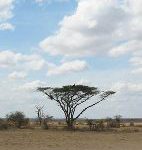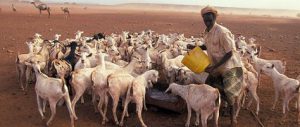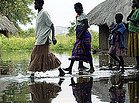Hawa Hassan comes leading three donkeys, accompanied by two female relatives and a handful of the family’s smallest children. They have walked out of the drought-withered acacia scrub, travelling 24 kilometres in a day to reach the Kenyan settlement of Makutano, not far from the border with Somalia.
Makutano is a sparse collection of tukuls – dome-shaped dwellings patched with cloth and tarpaulin and sections of woven-grass matting – scattered along the dirt road.
Passing through a fence of piled thorn around the settlement, Hawa and the other women unload branches from the donkeys’ backs. Quickly and dexterously, they bend and lash the boughs, framing an igloo-shaped structure in a few minutes, one of three that will be erected by the women in a sandy clearing among the low and spiny trees.
The men, says 55-year-old Hawa, are a day behind the women with what remains of their livestock – some camels and 18 goats out of the 40 they once owned. The rest perished through lack of water – or were slaughtered for meat so her family could survive a few more days on their journey.
As Hawa works the rough twine around the sticks, she describes in a few sentences the story that marks not simply the end for her family of generations of nomadic existence in the isolated lands where Kenya meets Somalia and Ethiopia, but the imminent collapse of a whole way of life that has been destroyed by an unprecedented decade of successive droughts.
“We have no water,” she explains, “and no food. We have left the pastures because we have lost so many goats. We had to come here to seek assistance. For the past two months, we have talked and talked about making this decision. We waited because we thought there might be some rain.”
And in these few minutes on arriving at Makutano, Hawa’s world is utterly transformed. A nomad when she walked in through its fence, in the moment of settling into its impoverished community she became something else instead: part of the burgeoning class of pastoral dropouts. No longer self-sufficient. Condemned to live at the very margins of Kenyan life. “I’m not sad that I came,” she says. “I can get water here. I don’t want to leave my life. If I could get some goats, then I would return to herding … I can’t feel good about being in a settlement. It has been forced on me. I don’t wish it for my life.”
A day later, I return to Makutano to find Hawa again, and to see how she has settled in. The men of her family have now joined the women. Children crowd outside the tukuls, eating porridge made of maize mixed with ground tree bark – a traditional coping technique during times of little food. But Hawa is not there. One group of Hawa’s relatives I do notice, however. A mother and young children, they sit eating next to the corpses of two of the family’s goats that had collapsed and died a few hours before.
Other family members are gathered quietly around something lying on the ground, the motionless figure of a woman in her late 60s, her face wrapped in a shawl. A grandmother, someone explains, she is sick from hunger and malaria. It does not look as if she will survive the evening.
What is happening in Kenya’s rangelands is the slow death of an existence, with families attempting to cling stubbornly to a land where the acacia scrub has been scorched to a spectral grey; where wind erosion scourges the possibility of life out of the fragile, desiccated soil. It has always been a hard living, herding goats, camels and bony cattle on the migration routes between the dry season and the wet season pastures. These days it looks close to impossible: the herders have begun slaughtering what precious stock has survived in order to feed their families.
Those trying to assist the nomads in the rangelands around the dusty town of Elwak on the Somalia border understand that there is a catch-22 in their efforts to help them: that external help – for all that it is desperately needed – may also be hastening the end of nomadic pastoralism in this region.
Where water is provided, delivered in a solitary tanker with a broken steering column, the nomads will gather, attracted by what is an occasional and insufficient supply of water. And be encouraged to drop out. New parts for the water truck can take up to three months to come from Nairobi, so its drivers have been forced to make their own uncomfortable decision: to drive it until it breaks completely rather than take it off the road for temporary repairs.
The watering points in the new settlements also attract wild animals. In the villages, we hear stories of infants and livestock snatched by predators.
And so far it is a very piecemeal relief effort. While some plastic water tanks are being trucked in by Kenya’s government, most settlements are reliant on dirty water pans – often shared by animals and humans.
While Hawa Hassan says she will miss her life among the tracts of thorn bushes, most recent pastoral dropouts interviewed by the Observer conceded that while in the past, perhaps, they had settled for brief periods, this time many are doing it for good.
The last drought – which began in 2005 – saw a dropout rate of close to 80%. This time the numbers are between 55% and 60%. But with no rains likely for weeks at the earliest, and then only the short rains, the situation is worsening by the day.
The current drought, which began when the rains failed once again in April, is not yet as bad as the drought that came in 2005 and left this area littered with the corpses of animals. But the animals are dying now, the weakest stumbling and falling, unable to get up again. And the consequence of a change in the global weather patterns that has seen three serious droughts within a decade, when previously a bad one occurred every nine to 12 years, has been a whittling away at the nomads’ capacity to restock with animals, to replenish and survive – normally a period of about three years.
The problems are exacerbated by the political marginalisation of this remote region – nearly 1,100 kilometres from Nairobi; its residents, mainly Muslims, have long been regarded with either suspicion or indifference by those in the capital.
The result has been a mounting desperation. Families that are rich enough have taken their animals hundreds of kilometres by truck to Mombasa on the coast to pasture them, or have had fodder brought from Nairobi. Those lacking in resources have been forced over the border to Somalia or into Ethiopia, where many have seen their cattle stolen by militias or have been drawn into sometimes violent conflicts over competition for resources.
One man, recently returned from Ethiopia, shows me a freshly healed wound on his throat, sustained in a fight before he was driven back across the border. Others speak of losing all their camels to raiders in Somalia. And not all these conflicts are occurring across the border.
One morning I accompany the limping government water truck on its deliveries. First stop is a settlement named Iresuki. A group of women wait by the road with empty 20-litre plastic canisters. As the tanker arrives a fight breaks out between several women desperate to get water.
The problem is explained. The tanker visits on average just once a week. The water it delivers lasts only four days. So those without access to donkeys to fetch water from elsewhere are forced to beg and borrow. Or go thirsty.
In another village, Dowder, I come across a temporary water pan – a tarpaulin laid into a broad trench in the earth – into which the tanker deposits water for livestock. A few muddy puddles are all that remain of the water.
Abdi Kher Hassan and Bishar Dahir are scooping up the puddles, a few spoonfuls at a time. “It’s for my family to drink,” says Abdi. “For our homes.” Unlike Hawa, Abdi has no wish to return to the rangelands and the nomadic way of life. He dropped out of pastoralism two and a half years ago. His life is not much better.
“When we had livestock, we had to move around,” he says with sad logic. “Now our livestock is gone, we don’t have to move. Before I had 50 goats. Now I have five. Those are ones that I’ll stay home with. I don’t want to go back to that life. It is too hard. My children are getting an education here. I don’t want them to follow their father and grandfathers as the situation gets worse.”
Bishar says they have chosen to settle on these remote and dusty roads so that their plight remains visible to the government. “If we went to the big towns, no one would notice us. We have settled here where people will notice us and where we can be helped.”
The escalating collapse of the pastoralist way of life is having a profound social impact on the dropouts, those on the verge of dropping out, and the few settled communities in the region.
At a bush madrasa, an irritable teacher with a stick beats children struggling to learn Islamic verses drawn with charcoal on flat sections of tree bark. Their parents, it transpires, are still in the bush trying to survive but have given their youngest children to relatives – who have already dropped out – to care for in settlement.
Other problems are more obvious. The dropouts congregating in Elwak and by the road have little access to health care and sanitation – a particular issue in the town, where the tukuls have sprung up around homes, behind the health care centre, and around the water towers. Most of the dropouts are lacking in any employment.
For the children, it is a particularly harsh existence. Close to the water towers in Elwak, Khadija Omar is standing over the body of the last of her 50 goats. She arrived in Elwak 10 days before. One of her children has pneumonia, another has malaria. She says she will survive by gathering firewood.
Ahmed Ibrahim, of Northern Aid, a local partner of the British charity Christian Aid, which is about to launch an appeal to counter the effects of the drought in Kenya, describes the situation of the nomads as desperate. “The pastoralists know that to take their livestock into areas like Somalia, where there is a war, is unsafe. It is a mark of their desperation.”
“The way the climate is changing – if it continues – it will be very difficult to sustain the nomadic way of living. It is a very hard task. We fear that soon people will begin dying not just from the lack of food but from a lack of water.”
He believes that despite the terrible conditions visible already, the nomads are currently only at the beginning of what has become a disaster.
The flight from drought
A third drought in a decade is afflicting the countries in the Horn of Africa. In Kenya, more than three million people are facing food and water shortages. The worst problems have been in the north of the country, where conflicts over resources have broken out between groups of nomadic pastoralists, killing dozens.
In desperation, some nomads have crossed the borders into Ethiopia and war-torn Somalia. Others have sent women and children to lead herds into the Tsavo national park to graze, while those who are wealthy enough have moved livestock by truck as far as Mombasa on the coast in search of grazing land.
www.guardian.co.uk
Copyright Guardian News and Media Limited 2009
Homepage image by hellofaboy



